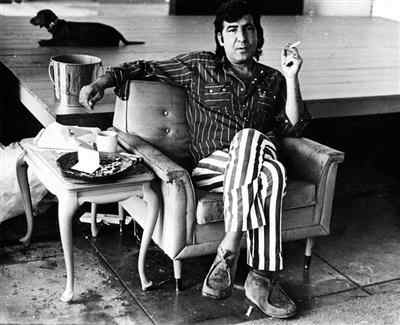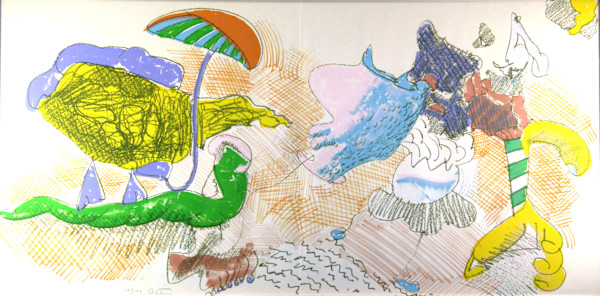
-
Artist: John Altoon ( Armenian, American , 1925-1969)
John Altoon (1925–1969) was an American artist known for his dynamic and often provocative abstract expressionist paintings and drawings. He was a key figure in the post-war Los Angeles art scene, particularly associated with the Ferus Gallery group, which played a crucial role in the development of the West Coast art movement. His work combined surrealist and abstract expressionist techniques with a playful, often erotic sensibility.
Early Life and Education:
Born: November 5, 1925, in Los Angeles, California, Altoon grew up in Southern California.
He studied at several prominent institutions, including the Otis Art Institute, Art Center College of Design, and the Chouinard Art Institute in Los Angeles. He also studied briefly in New York at the Art Students League, exposing him to the emerging abstract expressionist movement on the East Coast.
Artistic Style and Themes:
Abstract Expressionism: While his early works were influenced by abstract expressionism, with gestural brushstrokes and a loose, spontaneous style, Altoon’s work evolved into something more unique. His pieces often merged abstraction with recognizable forms, incorporating elements of figuration and surrealism.
Eroticism and Playfulness: A significant theme in Altoon’s work was eroticism, which he approached with both humor and boldness. His often sexually charged imagery was combined with whimsical figures, abstract forms, and cartoon-like shapes, creating an interplay between the absurd and the serious.
Surrealism and Freudian Influence: His drawings and paintings frequently explored dream-like, surrealist elements, reflecting an interest in the subconscious, inspired in part by Freudian psychoanalysis. He often depicted the human body in fragmented, exaggerated, or abstracted ways, drawing attention to both its beauty and its grotesque possibilities.
The Ferus Gallery and the Los Angeles Art Scene:
Altoon was a central figure in the Ferus Gallery, founded in Los Angeles by Walter Hopps and Ed Kienholz. The gallery became a cultural hub for avant-garde art in California and helped launch the careers of artists like Ed Ruscha, Robert Irwin, and Larry Bell.
He was also associated with the broader West Coast Cool School movement, known for its combination of abstract art, pop influences, and a laid-back, distinctly California aesthetic.
Notable Works:
Untitled (1958–1964): His untitled series often combined abstract, gestural forms with suggestive figuration, balancing chaos with precise, rhythmic compositions.
"Ocean Park Series": Though less widely known than his peers who worked in this style, Altoon contributed to the loose grouping of artists who painted the Ocean Park area of Los Angeles, using geometric abstraction to explore space, light, and color.
Drawings: Altoon’s drawings are among his most celebrated works, where he combined erotic figuration with surrealism, creating fluid, dreamlike compositions.
Struggles with Mental Health:
Altoon struggled with mental health issues throughout his life, particularly bipolar disorder. His mental health problems often led to erratic behavior, and he was hospitalized multiple times. Despite his personal struggles, he maintained a prolific artistic output, though his career was cut tragically short.
Death:
John Altoon died of a heart attack on February 25, 1969, at the age of 43. His early death, combined with his relatively brief career, limited his public recognition during his lifetime, though he remains an influential figure in the Los Angeles art world.
Legacy:
Posthumous Recognition: After his death, Altoon’s work gained wider recognition, and he is now considered a major figure in post-war American art, particularly within the context of the West Coast scene.
His work was the subject of a major retrospective at the Los Angeles County Museum of Art (LACMA) in 2014, which helped reestablish his importance as a key figure in American modern art.
Altoon’s art continues to be appreciated for its bold, provocative nature and its unique blend of abstraction, surrealism, and playful eroticism.
Altoon’s ability to blend serious artistic concerns with irreverent and often provocative subject matter has left a lasting impression on modern art, particularly within the context of 1960s Los Angeles. His work is held in major collections, including LACMA and the Museum of Modern Art (MoMA) in New York.
Powered by Artwork Archive


